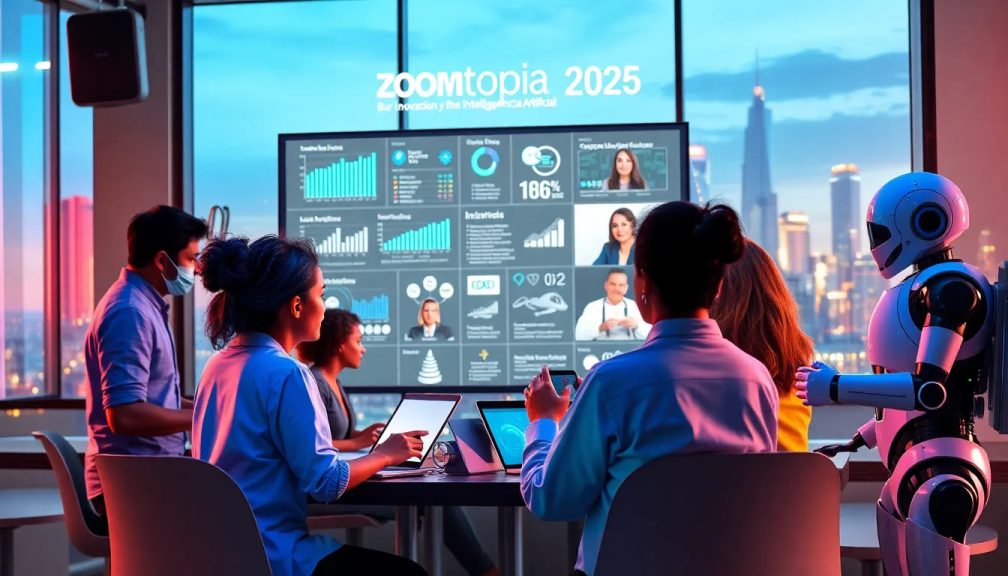Zoomtopia 2025 Innovation AI and Future of Work Insights

As the landscape of remote work continues to evolve, events like Zoomtopia provide crucial insights into how technology companies are adapting to meet the needs of their users. This year’s event, held virtually on September 17 under the theme “Zoom for the People,” highlighted the company’s commitment to fostering human connection and leveraging artificial intelligence (AI) in its platform. But with many organizations transitioning back to in-person work, the question remains: Can Zoom maintain its relevance and innovate fast enough in this changing environment?
In this article, we will explore key takeaways from Zoomtopia 2025, addressing pressing questions about the future of work and the role of AI in shaping that future.
- Where will Zoomtopia 2025 take place?
- Is Zoomtopia free for attendees?
- How is Zoom addressing the back-to-office trend?
- Is Zoom adopting AI effectively?
- What are the core strategies outlined by Zoom’s leadership?
- Why are partnerships essential for Zoom’s future?
- What are the challenges Zoom faces in staying competitive?
Where will Zoomtopia 2025 take place?
Zoomtopia 2025 is set to be a groundbreaking virtual gathering, emphasizing the importance of human connection in an increasingly digital world. While the exact platform details for the event are not finalized, the previous iterations have been held online, allowing global participation without geographical constraints. This format aligns with the ongoing shift towards more flexible work environments, encouraging attendees from around the globe to join in discussions about innovation and AI.
Is Zoomtopia free for attendees?
One of the standout features of Zoomtopia is its accessibility. The event is designed to be free for all participants, ensuring that anyone interested in the future of work and technology can benefit from the insights shared. This approach not only democratizes access to information but also enhances community engagement, allowing a diverse range of voices to contribute to the conversation.
How is Zoom addressing the back-to-office trend?
The trend of organizations urging employees to return to the office is a significant challenge for Zoom. Many companies that initially embraced remote work are now reinstating in-person meetings, leading to a potential decline in demand for video conferencing tools. However, Zoom is not backing down. Instead, CEO Eric Yuan emphasized that the platform is evolving beyond mere communication, positioning itself as an “AI work platform.”
This transformation includes:
- Enhanced Meeting Experiences: Zoom aims to make virtual meetings more productive and engaging than traditional in-person interactions.
- AI Companion Features: The introduction of advanced AI tools seeks to streamline workflows and improve productivity, making remote meetings more valuable.
- Focus on Milestones: The goal is to turn “moments of connection into milestones of completion,” ensuring that virtual interactions yield tangible outcomes.
Is Zoom adopting AI effectively?
The presence of AI dominated the discussions at Zoomtopia 2025, showcasing the company's ambition to integrate this technology into its offerings. One of the highlights was the unveiling of AI Companion 3.0, a tool designed to enhance productivity by managing tasks like note-taking and meeting summaries.
This introduces a new level of personalization and efficiency, as users can expect their digital twin to understand their preferences and workflows. Key features include:
- Automated Task Management: Handling scheduling and reminders without user intervention.
- Real-Time Insights: Offering meeting summaries and action items tailored to individual needs.
- Integration with Other Tools: Ensuring seamless interaction with external applications for a holistic workflow.
Yet, the competitive landscape poses challenges. Rivals like Microsoft and Google are also integrating AI into their platforms, making differentiation crucial for Zoom. While the AI enhancements are promising, the question remains: will they be sufficient to set Zoom apart in an increasingly crowded market?
What are the core strategies outlined by Zoom’s leadership?
During the keynote address, Zoom's leadership articulated a clear strategy focused on three main pillars, each essential for achieving their mission of “connecting people to progress.” These pillars are:
- It Just Works: Emphasizing simplicity and reliability as key advantages over competitors.
- Make Every Second Count: Utilizing AI to eliminate mundane tasks and free up time for meaningful work.
- What Matters to You: Prioritizing customer needs and experiences in platform development.
Additionally, initiatives like the “Zoom Solopreneur 50” index aim to recognize and elevate individuals and small businesses leveraging the platform for significant growth. This focus on community and customer-centric development strengthens Zoom's position as a fundamental tool across various sectors.
Why are partnerships essential for Zoom’s future?
Zoom's strategy emphasizes collaboration as a means of enhancing its ecosystem. High-profile partnerships, such as those with Cisco and Google, signify a commitment to interoperability and innovation. These alliances are crucial because:
- Integration with Hardware: The partnership with Cisco allows Zoom to work seamlessly with Cisco Room devices, enhancing user experience.
- Next-Generation Meeting Experiences: Collaborating with Google on platforms like Google Beam aims to provide immersive video experiences that rival advanced AR technologies.
- Shared Goals: Both companies recognize the importance of creating a cohesive ecosystem to improve productivity and user satisfaction.
This collaborative approach not only extends Zoom’s reach into new markets but also reinforces its identity as a versatile communication platform, often referred to as the “Switzerland” of workplace collaborations.
What are the challenges Zoom faces in staying competitive?
Despite the optimistic narrative presented at Zoomtopia 2025, the company grapples with significant challenges. The trend of returning to office work is gaining momentum, raising concerns about Zoom's long-term usage. Additionally, the competitive landscape is fierce:
- Bundled Solutions: Microsoft Teams is integrated with Office 365, making it a default choice for many organizations.
- Google’s Ecosystem: Google Workspace’s synergy with Gmail and Docs provides a competitive advantage.
- Established Hardware Presence: Cisco's dominance in enterprise hardware can overshadow Zoom's software-centric approach.
These factors contribute to a risk where Zoom might be perceived as a feature rather than a standalone platform. If competitors launch similar innovations, Zoom's incremental advancements may not be enough to maintain user loyalty.
Ultimately, while Zoom is actively innovating and expanding its offerings, the road ahead is fraught with uncertainties. The viability of its AI-driven features and partnerships will be tested as the company navigates through a landscape that is rapidly shifting back towards traditional work models.
As we move towards a future where AI and collaboration tools play a pivotal role, the ongoing evolution of platforms like Zoom will shape how organizations adapt to new working paradigms. The stakes are high, and the next few years will be crucial for determining whether Zoom can secure its place at the forefront of the digital workspace revolution.
To delve deeper into the future of work and innovation showcased at Zoomtopia 2025, check out this insightful video:




Leave a Reply